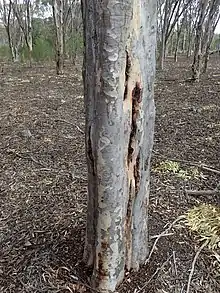Eucalyptus astringens
Eucalyptus astringens, commonly known as brown mallet[3] or to Noongar people as mallat, woonert or wurnert,[4] is a tree that is endemic to the South West region of Western Australia. It has smooth, shiny bark on its trunk and branches, lance-shaped leaves, pendulous flower buds arranged in groups of seven, cream-coloured to pale lemon-coloured flowers and cup-shaped to bell-shaped or conical fruit. This tree has also been introduced to Victoria.
.jpg.webp)

.jpg.webp)

| Brown mallet | |
|---|---|
 | |
| Eucalyptus astringens growing at Loxton, South Australia | |
| Scientific classification | |
| Kingdom: | Plantae |
| Clade: | Tracheophytes |
| Clade: | Angiosperms |
| Clade: | Eudicots |
| Clade: | Rosids |
| Order: | Myrtales |
| Family: | Myrtaceae |
| Genus: | Eucalyptus |
| Species: | E. astringens |
| Binomial name | |
| Eucalyptus astringens | |
Description
The tree typically grows to a height of 1.5 to 15 metres (5 to 49 ft) and can get to 24 m (79 ft) tall. It has smooth grey-brown coloured bark that peels from the trunk and branches. It blooms from August to December and produces white cream to yellow flowers.[3] At breast height the trunk has a diameter of around 7 m (23 ft). It is drought tolerant and grows in areas with rainfall of 300 to 400 millimetres (11.8 to 15.7 in) per year.[5] The concolorous, glossy, green adult leaves have an alternate arrangement. The leaf blade has a lanceolate shape and are 6 to 14 centimetres (2 to 6 in) long and 1 to 3.5 centimetres (0.4 to 1.4 in) wide. The unbranched inflorescences have an axillary arrangement. Each inflorescence is seven-flowered with flattened peduncles around 3.4 cm (1.3 in) flattened. The buds are pedicellate with a stubby to elongated shape. The fruits that form later are pedicellate and cupular to campanulate. Each fruit is around 1.2 cm (0.5 in) with a diameter of around 1 cm (0.4 in). They each have a level to descending disc with three or four valves containing grey-black seeds with an ovoid to flattened-ovoid shape.[6]
Taxonomy
Brown mallet was first formally described in 1911 by Joseph Maiden who gave it the name Eucalyptus occidentalis var. astringens and published the description in the Journal of the Natural History and Science Society of Western Australia.[7][8] In 1924, Maiden raised the variety to species status in his book A Critical Revision of the Genus Eucalyptus.[9][10] The specific epithet (astringens) is a Latin word meaning "shrinking" or "binding".[11]
In 2002, Ian Brooker and Stephen Hopper described two subspecies:[12]
Distribution
Brown mallet is commonly found on rocky outcrops, ridges, breakaways, hills and on valley floors in the southern Wheatbelt, Great Southern and south west Goldfields-Esperance regions of Western Australia. It grows in red-brown gravelly clay, brown clayey sand, sandy loam, spongolite, laterite and sandstone based soils.[3]
It is commonly associated with E. wandoo making up the overstorey, especially when E. wandoo woodland is an adjacent community. Understorey species often include occasional Santalum acuminatum and Melaleuca scalena, and a sparse ground cover of common grasses and herbs such as Thysanotus patersonii, Trachymene pilosa, Pterostylis sanguineus, Austrostipa elegantissima, Austrodanthonia setacea group and Lomandra micrantha subsp. micrantha.[17]
E. astringens has become naturalised in Bacchus Marsh, north of Melbourne, in Victoria, where it had been used to stabilise soils.[6]
Uses
The wood from the tree is used for construction, mining timbers and for tool handles. It is also a good firewood. The bark contains around 40% tannin and could possibly be used for tanning leather and production of adhesives.[5] Around 8,000 hectares (19,768 acres) of the tree have been planted around Narrogin in plantations for timber production.[5]
See also
References
- Fensham, R., Collingwood, T. & Laffineur, B. 2019. Eucalyptus astringens. The IUCN Red List of Threatened Species 2019: e.T61906574A61906605. https://dx.doi.org/10.2305/IUCN.UK.2019-3.RLTS.T61906574A61906605.en. Downloaded on 20 September 2021.
- "Eucalyptus astringens". Australian Plant Census. Retrieved 8 March 2019.
- "Eucalyptus astringens". FloraBase. Western Australian Government Department of Biodiversity, Conservation and Attractions.
- "Noongar names for plants". kippleonline.net. Archived from the original on 20 November 2016. Retrieved 20 November 2016.
- "Brown mallet Eucalyptus astringens". Forest Products Commission. Retrieved 24 November 2017.
- "Eucalyptus astringens (Maiden) Maiden Brown Mallet". Vicflora. Royal Botanic Gardens Victoria. Retrieved 24 November 2017.
- "Eucalyptus occidentalis var. astringens". APNI. Retrieved 8 March 2019.
- Maiden, Joseph (1911). "Notes on Western Australian eucalypts, including description of new species". Journal of the Natural History & Science Society of Western Australia. 3 (2): 186–187. Retrieved 8 March 2019.
- "Eucalyptus astringens". APNI. Retrieved 8 March 2019.
- Maiden, Joseph (1924). A critical revision of the genus Eucalyptus (Volume 7). Sydney: N.S.W. Government Printer. pp. 55–56. Retrieved 8 March 2019.
- Brown, Roland Wilbur (1956). The Composition of Scientific Words. Washington, D.C.: Smithsonian Institution Press. p. 109.
- Brooker, M. Ian; Hopper, Stephen (2002). "Taxonomy of species deriving from the publication of Eucalyptus subseries Cornutae Benth. (Myrtaceae)". Nuytsia. 14 (3): 353. Retrieved 13 March 2019.
- "Eucalyptus astringens subsp. astringens". APNI. Retrieved 8 March 2019.
- "Eucalyptus astringens". Euclid: Centre for Australian National Biodiversity Research. Retrieved 8 March 2019.
- "Eucalyptus astringens subsp. redacta". APNI. Retrieved 8 March 2019.
- "Eucalyptus astringens subsp. redacta". FloraBase. Western Australian Government Department of Biodiversity, Conservation and Attractions.
- "Eucalyptus astringens (brown mallet) woodland". Wheatbelt woodlands. Retrieved 13 November 2016.
